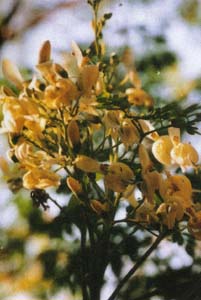Update:
2006-03-18 04:19 PM +0700
TIL
Medicinal Plants of Myanmar
Moringaceae
by Kyaw Soe and Tin Myo Ngwè, Forest Resource Environment Development and
Conservation Association (FREDA), Series 1, 2004, ISBN 974-91986-0-3
Copied by U Kyaw Tun, and staff of TIL
for staff and students of TIL. Not for sale.
Main Index of DB |
Top
Index of
Collected papers
Agri.Dept.2000:
Akshara
Science names |
Family names
Contents of this page
UKT: Nagathein references are given to check the Burmese-Myanmar names. *
shows where there is no agreement in Burmese name but when the plant is
identifiable from botanical name.
{dan.da.lun} ; {dan.tha-lun}
Moringa oleifera Lamk.2-087
Main Index of DB |
Top
Index of
Collected papers
Agri.Dept.2000:
Akshara
Science names |
Family names
Contents of this page
KS-TMN 162
{dan.da.lun} ; {dan.tha-lun}
Moringa oleifera Lamk.2-087
|
Botanical name: Moringa oleifera Lamk. Encyc. 1:398. 1785.
Myanmar names: Dant-da-lun; Dant-tha-lun.
English names: Drumstick Tree; Indian Horse-radish
Family: Moringaceae
Burmese-Myanmar name in Nagathein :2-087
{dan.da.lun} ; {dan.tha-lun}
Photos:
left -- habit with flowers
right -- habit with fruits
Click on the pictures to enlarge.
|
 |
 |
Identification characters:
A small or middle-sized tree, deciduous; bark gray, corky, wood soft, spongy,
the younger stems terete, tomentose. Leaves alternate, usually tripinnately
compound, imparipinnate; exstipulate; petioles cylindrical, pulvinate;
petiolules slender, pinnae and pinnules opposite, the pinnules (leaflets) 6-9
pairs, the terminal leaflet obovate, slightly larger than the lateral ones, the
lateral leaflets elliptic to oblong, the bases oblique, the margins entire, the
tips retuse, the upper surfaces puberulous, the lower glabrous; stipels as
minute glands at articulations. Inflorescences axillary paniculate cymes;
peduncles glabrous; bracts linear, minute. Flowers ebracteolate, pedicellate,
bisexual, zygomorphic, cymes; pentamerous, hypogynous. Perianth apophyllous,
2-seriate, sepals 5, elliptic, reflexed, unequal, borne on the rim of the
hypanthium, tomentose; petals 5, inserted on the rim of hypanthium, the anterior
petal elliptic, larger, erect, the other petals spathulate with curved claws,
reflexed, white to yellowish white, papillose, hypanthium cup-shaped. Androecium
polyandrous, stamens borne on the disc rim, the inner whorl of 5 fertile stamens
alternating with an outer whorl of 5 staminodes, the filaments unequal in
length, the bases dilated, tomentose, the anthers monothecous, oblongoid,
dorsifixed, dehiscence longitudinal. Pistil 1, ovary ellipsoid, 3-carpelled,
syncarpous, 1-loculed, stipitate, curved, villous, the ovules numerous, in 2
rows on each of 3 parietal placentae, pendulous, the style 1, slender, the
stigma truncate. Fruit a silique-like capsule, elongated, triquetrous, 3-valved,
9-ribbed; seeds globose, many, 3-winged, non-endospermic.
Flowering period: November-January
Fruiting period: December-February
Distribution: Planted
Parts used and uses: Bark and leaf decoction -- Analgesic for severe pains.
Bark of root -- Expectorant; Analgesic; Antiseptic; Aphrodisiac; Promotes
peristalsis of the intestine; Oedema; Indigestion; Emphysema of the lungs; Heart
disease; Eye disease; Otalgia; Lipoma; Heals boils and carbuncles. Leaf
-- Analgesic; Alcohol intoxication; Confusion; Hiccough; Asthma; Eye disease; Biliousness.
Flower -- Oedema; Ascites; Cancer; As an expectorant and carminative. Seed
-- Head-ache; Antidote for poisons; Eye disease.
Seed-oil -- Pruritis; Heals boils and carbuncles.
Main
Index of DB | Top
Contents of this page
End of TIL file

